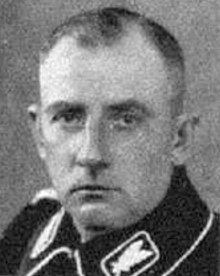You can help expand this article with text translated from the corresponding article in German. (June 2010) Click for important translation instructions.
|

Emil Sembach (April 2, 1891 – July 1, 1934) was an SS-Oberführer (Senior Colonel) attached to the SS headquarters of Silesia. He had joined the Nazi Party in 1925, and received promotion in the SS in 1931.
Biography
Emil Sembach was born on 2 April 1891, near Grein, Upper Austria.
Education
After studying at high school he went to a humanistic school in Coburg and graduated. Afterwards he joined as a cadet in a Magdeburg Artillery Regiment one.
Career
In the First World War he was a battery commander. From 1919 to 1921 he a member of a volunteer corps and fought in the Baltic states. Then earned it until 1932 his livelihood in commercial professions, most recently as assistant manager in Berlin. In 1934, after being caught by Reinhard Heydrich's Sicherheitsdienst (SD), for embezzlement and also for having a homosexual relationship with Curt Wittje, he was expelled from the party and the SS. Fearing for his life he asked Minister of the Interior Wilhelm Frick for protection, but his protection could not save him when on the Night of the Long Knives Sembach was arrested on the orders of his rival Udo von Woyrsch, and the next day under the command of SS-Obersturmführer (1st Lieutenant) Paul Exner, Sembach was taken to the Giant Mountains and executed on the orders of von Woyrsch.
References
- Lothar Gruchmann: Justice in the Third Reich 1933-1940. Adaptation and submission in the era of Gürtner, 2001, p. 459.
- Brigitte Hamann: Winifred Wagner, or, Hitler's Bayreuth, 2002, p. 281.
- Joachim Lilla, Martin Döring, Andreas Schulz: extras in uniform. The members of the Reichstag 1933-1945. A biographical handbook. Including the Völkisch and National Socialist Reichstag deputies from May 1924. Droste, Düsseldorf 2004, ISBN 3-7700-5254-4.
- Andreas Schulz/Günter Wegmann: The Generals of the Waffen SS and the Police, Vol. 3 (Lammerding-Plesch), 2008, p. 98.
This biographical article related to the military of Germany is a stub. You can help Misplaced Pages by expanding it. |
This biographical article related to the military of Austria is a stub. You can help Misplaced Pages by expanding it. |
- 1891 births
- 1934 deaths
- People from Lower Austria
- 20th-century Austrian people
- SS-Oberführer
- German Lutherans
- Austrian Lutherans
- German people of Austrian descent
- Members of the Reichstag 1933–1936
- Austrian people executed by Nazi Germany
- Executed Austrian Nazis
- 20th-century Freikorps personnel
- 20th-century Lutherans
- German Army personnel of World War I
- German military personnel stubs
- Austrian military personnel stubs
- Nazis killed during the Night of the Long Knives
- Nazis executed by Nazi Germany by firearm